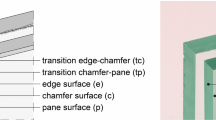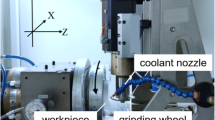Abstract
The demand for LCD (liquid crystal display) screens will maintain a rapid growth in the next decade. The high-speed edge-grinding process is important in this industry. One issue is the subsurface damage (SSD) induced by the edge-grinding. Glass is very sensitive to the micro-cracks of the processed surface. To investigate the SSD generated by the edge-grinding process, two grinding wheels with different grit sizes and bonding materials were employed to shape the edges of ultra-thin normal-glass panels and LCD-glass panels with 12 sets of grinding conditions. The cross-sectional microscopy, as a simple and direct assessment method, was utilized to measure the depths of subsurface cracks. It was found that bonding material, diamond concentration, and grit size imposed influences on the material removal mechanism of the edge-grinding process. The edge-grinding conducted using a wheel with grit size = 22–36 μm, diamond concentration = 100, and bonding material = resin induced little damage to the glass samples. With the smooth edge ground, the majority of the material was removed by plastic deformation. However, the subsurface damage of the LCD glass was smaller than that of the normal glass induced under the same grinding condition, and the LCD showed better machinability. The density of SSD of the LCD glass was also less than that of the normal glass.
Similar content being viewed by others
References
De Vaan ATSM (2007) Competing display technologies for the best image performance. J Soc Inf Disp 15(9):657–666
Minami H, Mori J, Iwai S, Moriya H, Watanabe N (2011) Manufacturing and inspection equipment for efficient production of large LCDs. Hitachi Rev 60(5):228–232
Suzuki N, Halai T (2009) Study on glass strength at high speed edge rounding for LCD. Key Eng Mater 389–390:448–452
Yu T, Li H, Wang W (2016) Experimental investigation on grinding characteristics of optical glass BK7: with special emphasis on the effects of machining parameters. Int J Adv Manuf Technol 82(5–8):1405–1419
Zhang J-H, Zhao Y, Tian F-Q, Zhang S, Guo L-S (2015) Kinematics and experimental study on ultrasonic vibration-assisted micro end grinding of silica glass. Int J Adv Manuf Technol 78(9–12):1893–1904
Zhong ZW (2003) Grinding of aluminium-based metal matrix composites reinforced with Al2O3 or SIC particles. Int J Adv Manuf Technol 21(2):79–83
Zhao Q, Liang Y, Stephenson D, Corbett J (2007) Surface and subsurface integrity in diamond grinding of optical glasses on Tetraform ‘C’. Int J Mach Tools Manuf 47(14):2091–2097
Zhong ZW (2003) Ductile or partial ductile mode machining of brittle materials. Int J Adv Manuf Technol 21(8):579–585
Zhong ZW (2002) Surface finish of precision machined advanced materials. J Mater Process Technol 122(2–3):173–178
Zhong ZW, Venkatesh VC (2009) Recent developments in grinding of advanced materials. Int J Adv Manuf Technol 41(5–6):468–480
Sun X, Stephenson DJ, Ohnishi O, Baldwin A (2006) An investigation into parallel and cross grinding of BK7 glass. Precis Eng 30(2):145–153
Jazi AY, Jay Liu J, Lee H et al. (2012) Automatic inspection of TFT-LCD glass substrates using optimized support vector machines, 8th IFAC Symposium on Advanced Control of Chemical Processes, Singapore, pp 325–330
Huet R, Ming W (2007) LCD display strength: why edge preparation matters, IEEE International Conference on Portable Information Devices, Orlando, FL, pp 1–4 (1-4244-1039-8/07)
Demirci I, Mezghani S, El Mansori M (2008) On material removal regimes for the shaping of glass edges: force analysis, surface topography and damage mechanisms. Tribol Lett 30(2):141–150
Demirci I, Mezghani S, Mkaddem A, Mansori ME (2010) Effects of abrasive tools on surface finishing under brittle-ductile grinding regimes when manufacturing glass. J Mater Process Technol 210(3):466–473
Camp DW, Kozlowski MR, Sheehan LM et al. (1997) Subsurface damage and polishing compound affect the 355-nm laser damage threshold of fused silica surfaces. Proc SPIE—Int Soc Optic Eng 356–364
Haapalinna A, Nevas S, Pähler D (2004) Rotational grinding of silicon wafers—sub-surface damage inspection. Mater Sci Eng B: Solid-State Mater Adv Technol 107(3):321–331
Zhang Z, Meng Y, Guo D, Kang R, Gao H (2010) Nanoscale machinability and subsurface damage machined by CMP of soft-brittle CdZnTe crystals. Int J Adv Manuf Technol 47(9–12):1105–1112
Pei ZJ, Billingsley SR, Miura S (1999) Grinding induced subsurface cracks in silicon wafers. Int J Mach Tools Manuf 39(7):1103–1116
Tönshoff HK, Karpuschewski B, Hartmann M, Spengler C (1997) Grinding-and-slicing technique as an advanced technology for silicon wafer slicing. Mach Sci Technol 1(1):33–47
Randi JA, Lambropoulos JC, Jacobs SD (2005) Subsurface damage in some single crystalline optical materials. Appl Opt 44(12):2241–2249
Shen J, Liu S, Yi K, He H, Shao J, Fan Z (2005) Subsurface damage in optical substrates. Optik 116(6):288–294
Li S, Wang Z, Wu Y (2008) Relationship between subsurface damage and surface roughness of optical materials in grinding and lapping processes. J Mater Process Technol 205(1-3):34–41
Li Y, Zheng N, Li H, Hou J, Lei X, Chen X, Yuan Z, Guo Z, Wang J, Guo Y, Xu Q (2011) Morphology and distribution of subsurface damage in optical fused silica parts: bound-abrasive grinding. Appl Surf Sci 257(6):2066–2073
Zhong ZW, Khoo LP, Han ST (2006) Prediction of surface roughness of turned surfaces using neural networks. Int J Adv Manuf Technol 28(7–8):688–693
Xu H (2012) Optimization of high speed grinding parameters for LCD glass, report of final year project. Nanyang Technological University, Singapore
Tian YB, Xu H (2013) Development of high-efficiency and crack-free grinding process for chamfering of LCD glass edge. In: Advances in Abrasive Technology Xvi, 240–245
Yang KH (1984) An etch for delineation of defects in silicon. J Electrochem Soc 131(5):1140–1145
Fathi M (2007) Delineation of crystalline extended defects on multicrystalline silicon wafers. Int J Photoenerg Vol. 2007:Article ID 18298
Zhong ZW (1997) Partial-ductile grinding, lapping, and polishing of aspheric and spherical surfaces on glass. Mater Manuf Process 12(6):1063–1073
Lv D, Huang Y, Tang Y, Wang H (2013) Relationship between subsurface damage and surface roughness of glass BK7 in rotary ultrasonic machining and conventional grinding processes. Int J Adv Manuf Technol 67(1–4):613–622
Zhong ZW (2000) Machining of glass molds for manufacturing plastic lenses. Mater Manuf Process 15(3):449–464
Author information
Authors and Affiliations
Corresponding author
Rights and permissions
About this article
Cite this article
Zhong, Z.W., Tian, Y.B. & Xie, T.G. Investigation of subsurface damage of ground glass edges. Int J Adv Manuf Technol 87, 3261–3269 (2016). https://doi.org/10.1007/s00170-016-8733-y
Received:
Accepted:
Published:
Issue Date:
DOI: https://doi.org/10.1007/s00170-016-8733-y




